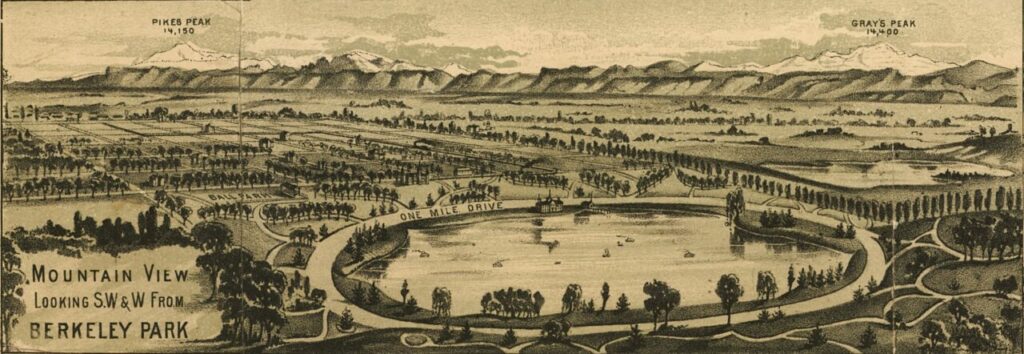By Rebecca Hunt
The Northside is made up of many neighborhoods. In the past year or so you have heard about Highland, Jefferson Park and Sunnyside. This month we are moving on to the Berkeley neighborhood. I plan to do a series of pieces on Berkeley and then Regis in the coming few months.
Berkeley lies between Federal Boulevard, West 38th, West 52nd and Sheridan Boulevard. According to the Historic Berkeley Regis Facebook page, when U.S. surveyor John Pierce reported on this area, he felt that the river bottoms around Clear Creek and down to the South Platte offered good farmland, but that the uplands were only likely to be useful for grazing. He did note that a good road ran through the area, from Denver up toward the Overland Trail in Wyoming.
The early days of the Berkeley neighborhood actually date back to the end of the mountain man era when Jim Baker, the retired Colorado and Wyoming fur trapper and trader, ran his ferry, toll bridge, stage stop and general store on Clear Creek near modern 52nd Avenue. Baker was one of the earliest Anglo-Americans living there. Once the government released the survey, which included a mention of Baker, a variety of developers began to buy up acreage.
One of those land speculators was John Brisben Walker who established Berkeley Farm, his alfalfa operation. He came to Colorado in 1885 hoping to test the idea that our state was a good place to grow alfalfa. Another of his early projects included assisting the development of the Highland Park subdivision in Highland.
Walker also wanted to create a resort, which he named after Berkeley Springs, West Virginia.
Walker spent much of his career developing properties that would attract the elites of Colorado and beyond. These included building a mansion on Mount Falcon near Morrison that he hoped would become the summer White House. He also worked to create an entertainment venue at Red Rocks and an entertainment complex north of downtown Denver, along the South Platte River.
Two other men bought up property and became some of the founding fathers of Berkeley. They were Carleton Ellis and John McDonough, who bought out Walker when he moved to New York City to take over Cosmopolitan magazine. They began to sell plots of land, many of which were laid out by Ellis who, with Hiram Wolff, platted parts of Highland and early sections of Berkeley. The main residential street became West 46th, and Tennyson grew to be the main commercial district. Many of the first homes built in the town were solidly built brick classic cottages. These were punctuated by elegant mansions designed by some of Denver’s most prominent architects.
One of the early amenities was a park on a lake created out of a shallow pond with pockets of warm springs. Named Berkeley Lake Park, it was a popular site for family and community events. The park eventually included a swimming beach and a bathhouse. The park was on the western end of the community, near Sheridan Boulevard, bordering West 46th. At the neighborhood’s eastern end was Rocky Mountain Lake, carved out of a buffalo wallow. It bordered Federal Boulevard.

Berkeley leaders decided in 1892 to create their own municipal government. The town of North Denver became a reality in June of that year. The new town had artesian wells and laws regulating saloons. Like their Highland neighbor, they saw themselves as above Denver, both literally and figuratively, and legislated accordingly. They wanted to attract a good class of residents.
But by 1898, it was clear that the town had an identity crisis. People did not know if it was its own place or a section of Denver. That prompted town fathers to rename their community Berkeley. In 1902, a state law created the city and county of Denver. Very quickly that city began to annex small towns around its borders. Globeville, Highland and Berkeley soon became part of the new city and county. A new era had begun.
Dr. Rebecca A. Hunt has been a resident of North Denver since 1993. She worked in museums and then taught museum studies and Colorado, Denver, women’s and immigration history at the University of Colorado Denver until she retired in 2020.
Note from the columnist:
Recently I have received some corrections to my columns. After I wrote my January piece on the Navajo Street arts district, I received a few corrections and clarifications from Chandler Romeo. Thank you, Chandler. Here is what I learned.
The Pirate Art Gallery moved to the southwest corner of West 37th and Navajo in January 1982. They rented from the Levin family, who had run their dry goods store there for many years. Reed Weimer moved into the second-floor apartment in that corner building later that year.
The Next gallery did not open there until around 2005 or 2006. Core Gallery was never at West 37th and Navajo. And finally, regarding the Bug Theatre, “The Telephone” was an operetta by Gian Carlo Menotti, not a play. Rest assured, if I make an error, I depend on my readers to help me get it right. Thank you for reading and for keeping me honest.

Be the first to comment